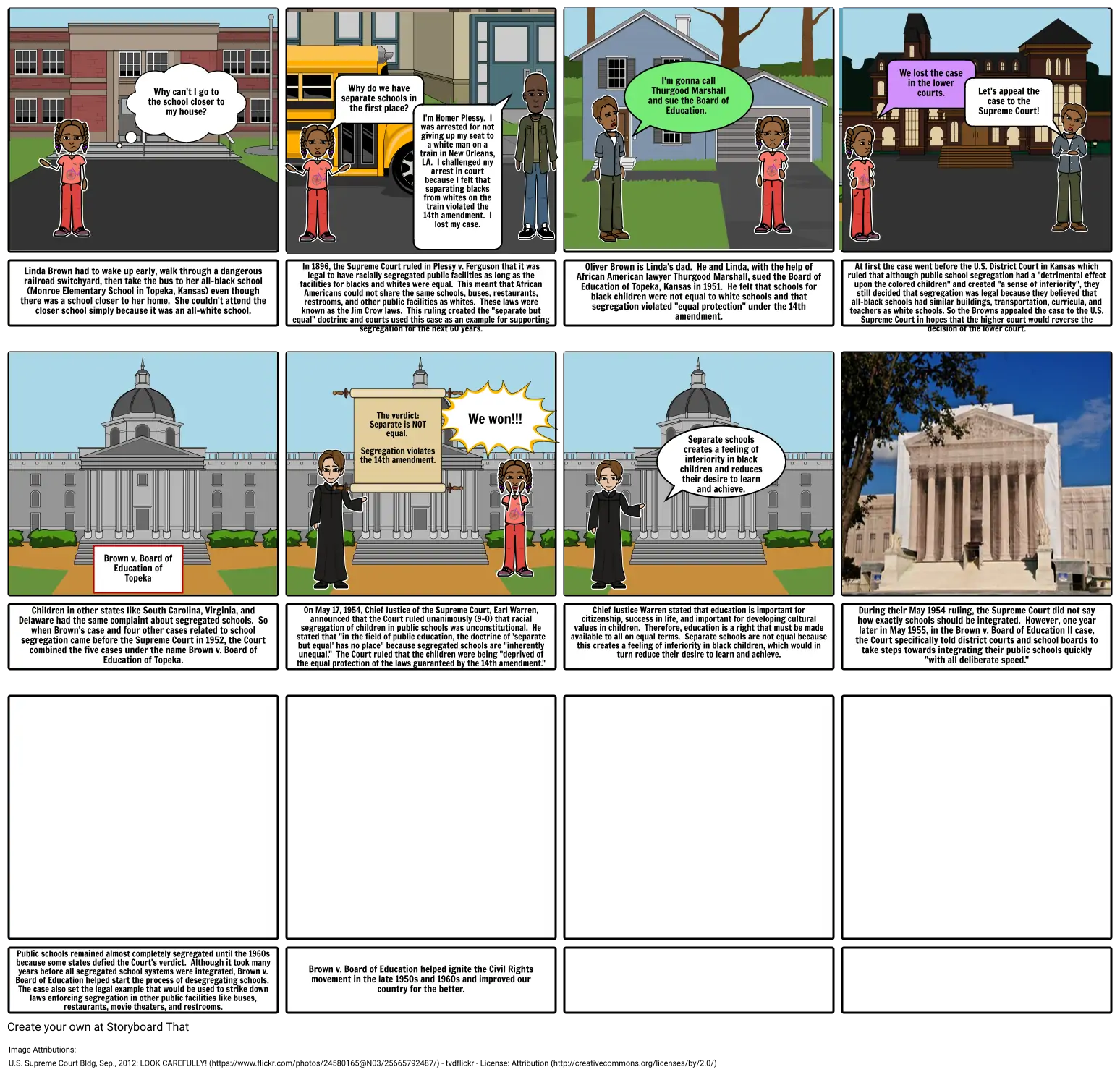Brown v Board of Education

Storyboard Text
- Why can't I go to the school closer to my house?
- Why do we have separate schools in the first place?
- I'm Homer Plessy. I was arrested for not giving up my seat to a white man on a train in New Orleans, LA. I challenged my arrest in court because I felt that separating blacks from whites on the train violated the 14th amendment. I lost my case.
- I'm gonna call Thurgood Marshall and sue the Board of Education.
- We lost the case in the lower courts.
- Let's appeal the case to the Supreme Court!
- Linda Brown had to wake up early, walk through a dangerous railroad switchyard, then take the bus to her all-black school (Monroe Elementary School in Topeka, Kansas) even though there was a school closer to her home. She couldn't attend the closer school simply because it was an all-white school.
- In 1896, the Supreme Court ruled in Plessy v. Ferguson that it was legal to have racially segregated public facilities as long as the facilities for blacks and whites were equal. This meant that African Americans could not share the same schools, buses, restaurants, restrooms, and other public facilities as whites. These laws were known as the Jim Crow laws. This ruling created the "separate but equal" doctrine and courts used this case as an example for supporting segregation for the next 60 years.
- The verdict: Separate is NOT equal. Segregation violates the 14th amendment.
- We won!!!
- Oliver Brown is Linda's dad. He and Linda, with the help of African American lawyer Thurgood Marshall, sued the Board of Education of Topeka, Kansas in 1951. He felt that schools for black children were not equal to white schools and that segregation violated "equal protection" under the 14th amendment.
- Separate schools creates a feeling of inferiority in black children and reduces their desire to learn and achieve.
- At first the case went before the U.S. District Court in Kansas which ruled that although public school segregation had a "detrimental effect upon the colored children" and created "a sense of inferiority", they still decided that segregation was legal because they believed that all-black schools had similar buildings, transportation, curricula, and teachers as white schools. So the Browns appealed the case to the U.S. Supreme Court in hopes that the higher court would reverse the decision of the lower court.
- Children in other states like South Carolina, Virginia, and Delaware had the same complaint about segregated schools. So when Brown's case and four other cases related to school segregation came before the Supreme Court in 1952, the Court combined the five cases under the name Brown v. Board of Education of Topeka.
- Brown v. Board of Education of Topeka
- On May 17, 1954, Chief Justice of the Supreme Court, Earl Warren, announced that the Court ruled unanimously (9-0) that racial segregation of children in public schools was unconstitutional. He stated that "in the field of public education, the doctrine of 'separate but equal' has no place" because segregated schools are "inherently unequal." The Court ruled that the children were being "deprived of the equal protection of the laws guaranteed by the 14th amendment."
- Chief Justice Warren stated that education is important for citizenship, success in life, and important for developing cultural values in children. Therefore, education is a right that must be made available to all on equal terms. Separate schools are not equal because this creates a feeling of inferiority in black children, which would in turn reduce their desire to learn and achieve.
- During their May 1954 ruling, the Supreme Court did not say how exactly schools should be integrated. However, one year later in May 1955, in the Brown v. Board of Education II case, the Court specifically told district courts and school boards to take steps towards integrating their public schools quickly "with all deliberate speed."
- Public schools remained almost completely segregated until the 1960s because some states defied the Court's verdict. Although it took many years before all segregated school systems were integrated, Brown v. Board of Education helped start the process of desegregating schools. The case also set the legal example that would be used to strike down laws enforcing segregation in other public facilities like buses, restaurants, movie theaters, and restrooms.
- Brown v. Board of Education helped ignite the Civil Rights movement in the late 1950s and 1960s and improved our country for the better.
-
-
Image Attributions
- U.S. Supreme Court Bldg, Sep., 2012: LOOK CAREFULLY! - tvdflickr - (License Attribution )
Over 30 Million Storyboards Created

